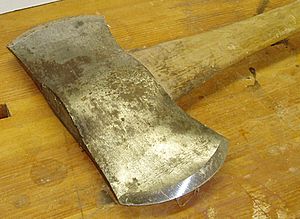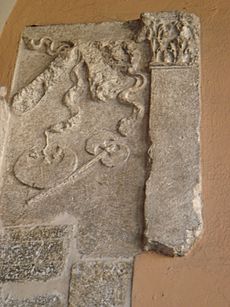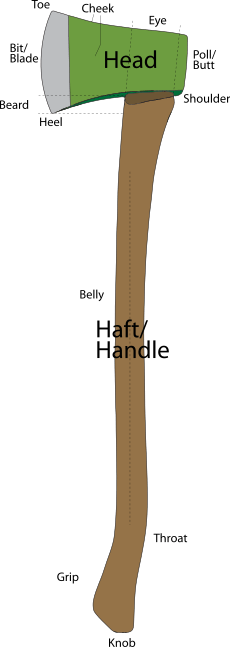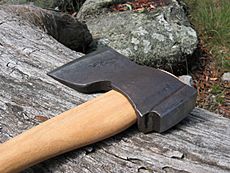Axe facts for kids
An axe (or ax) is an ancient tool. It is used to shape, split and cut wood.
The hand axe was probably the first tool in the Stone Age. It did not have a handle.
In the past, axes were used as weapons by soldiers. Today, axes are usually related to woodcutters and firemen.
Axes are simple machines. They are in the category of wedges. They are usually made of some sort of metal, mainly steel or iron. They can have a metal or wooden handle.
Contents
History
Initially axes were tools of stone called hand axes, used without handles (hafts), and had knapped (chipped) cutting edges of flint or other stone. Axes made with ground cutting edges are known since the Neolithic period ending 4,000 to 2,000 BC. The first true hafted axes are known from the Mesolithic period (c. 6000 BC). Few wooden hafts have been found from this period, but it seems that the axe was normally hafted by wedging. Birch-tar and raw-hide lashings were used to fix the blade.
Sometimes a short section of deer antler (an "antler sleeve") was used, which prevented the splitting of the haft and softened the impact on the stone blade itself, helping absorb the impact of each axe blow and lessening the chances of breaking the handle. The antler was hollowed out at one end to create a socket for the axehead. The antler sheath was then either perforated and a handle inserted into it or set in a hole made in the handle instead.
The distribution of stone axes is an important indication of prehistoric trade. Thin sectioning is used to determine the provenance of the stone blades. In Europe, Neolithic "axe factories", where thousands of ground stone axes were roughed out, are known from many places, such as:
- Great Langdale, England (tuff)
- Rathlin Island, Ireland (porcellanite)
- Krzemionki, Poland (flint)
- Plancher-les-Mines, France (pelite)
- Aosta Valley, Italy (omphacite).
Stone axes are still produced and in use today in parts of Papua, Indonesia. The Mount Hagen area of Papua New Guinea was an important production centre.
Parts of the axe
The axe has two primary components: the axe head, and the haft.
The axe head is typically bounded by the bit (or blade) at one end, and the poll (or butt) at the other, though some designs feature two bits opposite each other. The top corner of the bit where the cutting edge begins is called the toe, and the bottom corner is known as the heel. Either side of the head is called the cheek, which is sometimes supplemented by lugs where the head meets the haft, and the hole where the haft is mounted is called the eye. The part of the bit that descends below the rest of the axe-head is called the beard, and a bearded axe is an antiquated axe head with an exaggerated beard that can sometimes extend the cutting edge twice the height of the rest of the head.
The axe haft is sometimes called the handle. Traditionally, it was made of a resilient hardwood like hickory or ash, but modern axes often have hafts made of durable synthetic materials. Antique axes and their modern reproductions, like the tomahawk, often had a simple, straight haft with a circular cross-section that wedged onto the axe-head without the aid of wedges or pins. Modern hafts are curved for better grip and to aid in the swinging motion, and are mounted securely to the head. The shoulder is where the head mounts onto the haft, and this is either a long oval or rectangular cross-section of the haft that is secured to the axe head with small metal or wooden wedges. The belly of the haft is the longest part, where it bows in gently, and the throat is where it curves sharply down to the short grip, just before the end of the haft, which is known as the knob.
Types of axes
Axes designed to cut or shape wood
- Felling axe: Cuts across the grain of wood, as in the felling of trees. In single or double bit (the bit is the cutting edge of the head) forms and many different weights, shapes, handle types and cutting geometries to match the characteristics of the material being cut. More so than with for instance a splitting axe, the bit of a felling axe needs to be very sharp, to be able to efficiently cut the fibres.
- Splitting axe: Used in wood splitting to split with the grain of the wood. Splitting axe bits are more wedge shaped. This shape causes the axe to rend the fibres of the wood apart, without having to cut through them.
- Broad axe: Used with the grain of the wood in precision splitting or "hewing" (i.e. the squaring-off of round timbers usually for use in construction). Broad axe bits are most commonly chisel-shaped (i.e. one flat and one beveled edge) facilitating more controlled work as the flat cheek passes across the squared timber.
- Adze: A variation featuring a head perpendicular to that of an axe. Rather than splitting wood side-by-side, it is used to rip a level surface into a horizontal piece of wood. It can also be used as a pickaxe for breaking up rocks and clay.
- Hatchet: A small, light axe designed for use in one hand specifically while camping or travelling.
- Carpenter's axe: A small axe, usually slightly larger than a hatchet, used in traditional woodwork, joinery and log-building. It has a pronounced beard and finger notch to allow a "choked" grip for precise control. The poll is designed for use as a hammer.
- Hand axe: A small axe used for intermediate chopping, similar to hatchets.
- Mortising axe: Used for creating mortises, a process which begins by drilling two holes at the ends of the intended mortise. Then the wood between the holes is removed with the mortising axe. Some forms of the tool have one blade, which may be pushed, swung or struck with a mallet. Others, such as twybil, bisaigüe and piochon have two, one of which is used for separating the fibres, and the other for levering out the waste.
Images for kids
-
A collection of bronze socketed axe blades from the Bronze Age found in Germany. This was the prime tool of the period and also seems to have been used as a store of value.
-
Shang dynasty axe
-
Jade axe, Shang dynasty
-
A collection of old Australian cutting tools including broad axes, broad hatchets, mortising axes, carpenter's and felling axes. Also five adzes, a corner chisel, two froes, and a twybil
-
Firefighter with a fire axe
See also
 In Spanish: Hacha para niños
In Spanish: Hacha para niños















